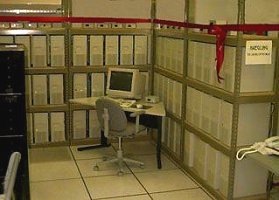





Caltech Brings High-Performance Computing to the K-12 Classroom
In the past few years, teachers at K-12 schools across the nation have determined that computer proficiency is essential for their students if they are to have the tools and skills necessary to succeed in future studies and careers. While many schools are striving to acquire enough personal computers (PCs) and training resources to meet student needs, scientists at the Center for Advanced Computing Research (CACR) at Caltech have taken a leap into the future by making the power of parallel computation available in the classroom.
CACR researchers have constructed a Beowulf computer system named Hrothgar that is enabling math, science, and technology teachers at local Southern California schools to perform simulations and analyses not feasible on classroom computers. The system works by applying multiple PCs to large-scale problems in science and engineering. The PCs are connected by commodity networks and run software that can apply all the PCs to a single application, delivering supercomputer performance at the lowest possible price.
In a typical classroom scenario, the Beowulf system and a scientific application code are employed in a four-step exercise. The teacher first explains the underlying science of the computer model and then demonstrates the computer program. Next, the students run the program with their choice of parameters. In the final step, the students view the simulation results and discuss the findings. Completing this exercise on a PC would require 24 hours, but by using Hrothgar, teachers can perform several computer simulations each hour.
 CACR researchers at Caltech have constructed a Beowulf computer system that is enabling math, science, and technology teachers at local Southern California schools to perform simulations and analyses not feasible on classroom computers
CACR researchers at Caltech have constructed a Beowulf computer system that is enabling math, science, and technology teachers at local Southern California schools to perform simulations and analyses not feasible on classroom computers |
The system is initially being used with the California Institute of Technology (CIT) Air Quality Model (AQM) in cooperation with Mani Chandy of Caltech and Donald Dabdub of University of California at Irvine. This problem solving environment for airshed modeling enables teachers and students to use parallel computing to study air pollution patterns in the South Coast Air Basin of California.
"The primary goal for schoolchildren is to show them the importance of science in their daily lives in an immediate and direct way," says Chandy. "Science comes alive with tools that help students drive scenarios where they can understand the impact of temperature, wind patterns, automobiles, electric vehicles, biomass, and factories on the air that they breathe."
The Beowulf system also offers the GENESIS neural simulator, in cooperation with James Bower of Caltech. The GENESIS platform was developed to support the simulation of neural systems ranging from complex models of single neurons to large networks made up of more abstract neuronal components. Most current applications involve realistic simulations of biological neural systems. Both the AQM and GENESIS have user-friendly interfaces that facilitate their use in the K-12 setting.
The participating schools are part of EdTech, the Foothills Educational Technology Forum. For information on EdTech, contact Jim Davis at jwilsondav@aol.com. For more information on the Beowulf project, contact Dan Davis, ddavis@cacr.caltech.edu, (626) 395-3766; Tom Gottschalk, tdg@cacr.caltech.edu; or visit the K-12 Beowulf home page at http://cacr.caltech.edu/~ddavis/K12-Beowulf.
 Other Issues of PCR Other Issues of PCR
|
 Back to PCR Back to PCR
|
CRPC Home Page |